There is a seemingly small, but important change happening in the industry, and that is 1U servers are finally catching the storage density of the 2U 24-bay storage servers. With 12x front panel hot-swap bays, the value proposition is straightforward, one gets 20% more storage density compared to 10-bay designs. Squeezing two extra drives into a chassis that already looked “full” with 10-bays is no small feat, so we wanted to see how this is accomplished. As such, we are looking at the Supermicro SYS-1029U-TN12RV which is part of the Supermicro Ultra line to see how this is accomplished.
Video Version
This is part of our visit to the Supermicro HQ post-lockdown series. We previously looked at the Supermicro 3rd Gen Xeon Scalable Server which we showcased alongside the Cooper Lake launch. We also looked at the Simply Double, 1U EDSFF, and the company’s new 60-Bay Top Loading Storage Server. More recently, we looked at the pole-mounted IP65 Rated Supermicro Outdoor Edge System. As a part of that series, we have an accompanying video:
We are going to have more detail in this article, but want to provide the option to listen. As a quick note, Supermicro filmed the video bits at their HQ, provided the systems in their demo room, and their product managers that were able to make it. We did a whole series but are tagging this as sponsored since we relied upon their facilities instead of our own. I was able to pick the products we would look at and have editorial control of the pieces (nobody is reviewing these pieces outside of STH before they go live either.) In full transparency, this was the only way to get something like this done, including looking at a number of products in one shot, without going to a trade show during shelter-in-place. Look for more in this series coming to STH over the coming weeks.
Supermicro Ultra SYS-1029U-TN12RV Hands-On
This is the front of the Supermicro SYS-1029U-TN12RV server. Perhaps the most notable feature of this 1U Supermicro Ultra design is the twelve 2.5″ drive bays.

Getting 12x 2.5″ drive bays is challenging. You will notice that the drive trays are a different design than the standard 2.5″ drive trays. In order to reclaim horizontal space, each drive tray has to be redesigned to use thinner side brackets and a different latching mechanism. These drives can be NVMe but with a storage controller, they can be SAS or SATA as well.
Inside the server, we have dual Intel Xeon Scalable processors. The Ultra line has a full 12 DIMMs per CPU or 24 DIMMs total. These servers can support up to 512GB Intel Optane PMem 100 (DCPMM) modules for high-capacity configurations. The 512GB modules can run at higher power levels increasing heat so servers need to be specifically designed to run at these higher PMem 100 power levels.
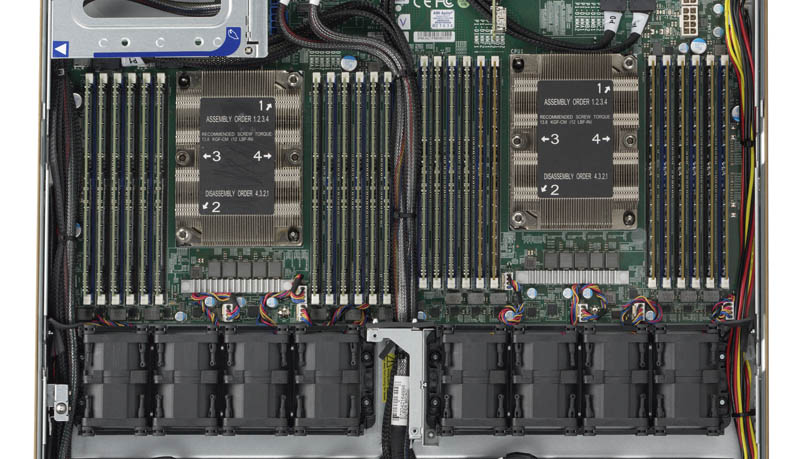
Another feature is expansion. One can get a double-width card such as a GPU installed. There is also a PCIe x8 slot that sits in the middle of the chassis just over the PCH.
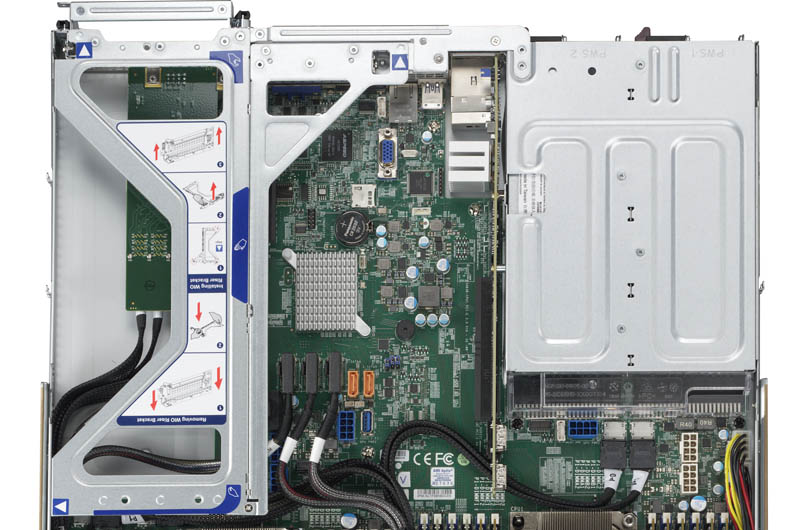
These systems use the Supermicro Ultra 1U network risers. In this example, we have two 25GbE ports on the riser as well as an internal PCIe slot. That internal PCIe slot is often used for cards such as SAS controllers.

Supermicro has sold 1U Ulta servers for generations. The big change with this model are the 12x 2.5″ bays. This required new trays and new front components to utilize new trays in order to fit all of these drives into the system.
While doing this hands-on in the Supermicro demo room, we saw a new product we had never seen nor heard of before so we naturally had to look at it.
Hands-on with the Upcoming Supermicro SYS-2029U-MTNRV
There was another system that I saw in the demo room that we did not plan to cover, but when I saw it, I was completely intrigued by it. The Supermicro SYS-2029U-MTNRV was still an earlier version when we saw it about a month and a half before publishing this piece, and as of this piece going live, it is still a future product, but we are told it is coming soon. The system takes the normal internals of an Ultra 2U server, removes some front panel storage, and creates a short-depth platform.
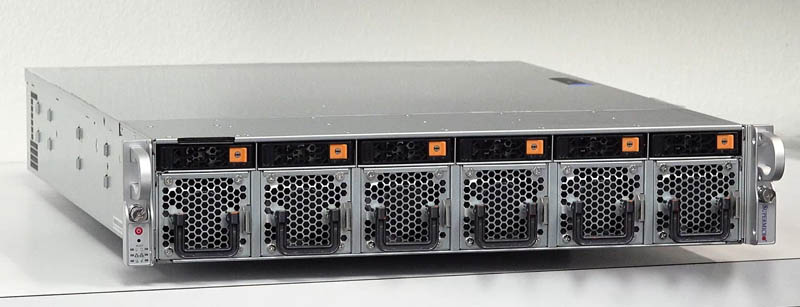
As you can see, the top of this chassis is using 6x 2.5″ bays or one row of the above 1U 12-bay server. The rest of the front is comprised of hot-swap fan modules.
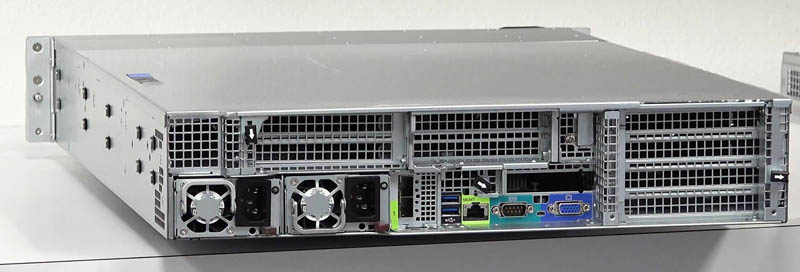
The rear of the unit is a standard Supermicro 2U Ultra configuration with PCIe risers. Because the front of the chassis has fewer drives, not only is this shorter depth (22.6″ / 574mm versus usually around 27.76″ / 705.3mm) but it also offers better cooling for high-end components such as Intel N3000 FPGA network cards, GPUs, and other expansion cards. That is due to less airflow restriction due to hot-swap drive bays compared with 26-bay designs.
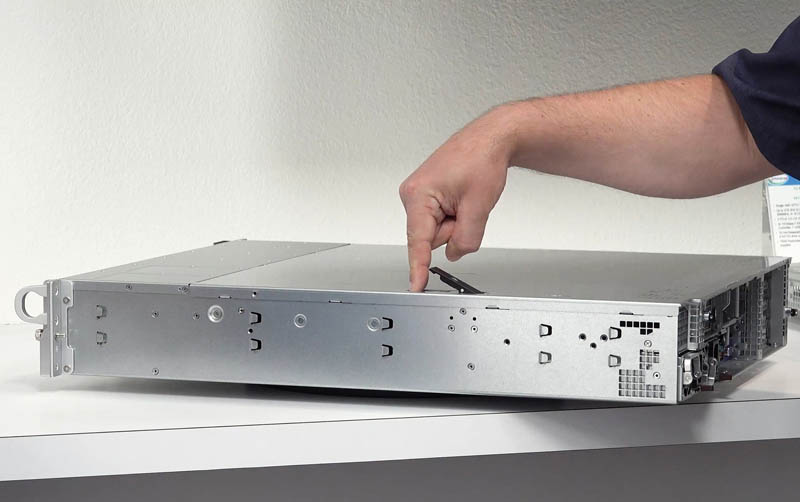
One other small design update on this system, it has a new latching mechanism. Supermicro servers typically use push tab retention to keep the top cover on. This is the first Ultra server to have a latch. Hopefully, the latch will find its way into more of the company’s designs in the future.
Final Words
The foundational element of these new Supermicro servers goes back to the new 2.5″ drive trays and front bay infrastructure. With two rows of six drives, one gets the 1U 12-bay Supermicro Ultra platform. With a single row of these drives, one can get a significantly more compact 2U platform. Beyond the drive trays, another item that ties these very different systems together is the motherboard. Both use the Supermicro X11DPU-V and that is an important facet for the Ultra line. Using the same motherboard across different designs and form factors drives up volume and quality. It also makes it easier for organizations to qualify the design across form factors.
Overall, this is an example where a seemingly small innovation of being able to fit 6 drives in half a U of front server area can have a big impact across multiple lines.

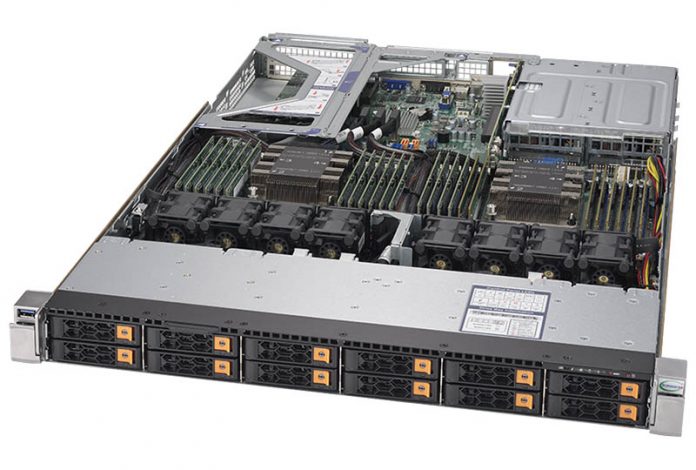



strange, that supermicro is still with intel while amd epyc is more value and more powerfull features against intel scalable-platform….very strange….or maybe is supermicro getting some kind of money
What’s with the VGA port on the server motherboard? That’s the first time I’ve seen such a thing.
I meant, what is with the VGA port inside the chassis on the motherboard? What is it used for?
Do these servers have something like “list price” for the barebones?
Erik, Intel is SMCI’s biggest customer…
I wonder why they stick with 2.5″ form factor for the SSDs? If they had slot-in bays for M.2 80mm cards they could fit 50 drives in the front.
It’d be another bit of engineering but by no means impossible.
@Patrick do you have some insight on this kind of idea?
Emerth – that is the idea behind EDSFF.
@Patrick – thanks!
Will you be reviewing the AS-1124US-TNRP?
I’m waiting for Milan to ditch Intel, but it looks exciting (though I would like SM to adopt OCP 3.0 NICs…)
Patrick B we may look into that closer to Milan.
I agree with the above poster. SM needs to give AMD more attention.
We know there are limits to the amount of PCIe lanes you can achieve with Intel-based servers, so I’d be curious to understand if this reviewed system uses any sort of PCIe switch to allow for oversubscription of the NVMe drives. Additionally, I’d like to understand the thermal limitations to this sort of configuration. When you add GPUs + 24 DIMMs + dual Intel CPUs and NVMe drives, there MUST be some sort of power limit (i.e. no CPUs over 150w).
Kevin, we discuss this a bit in the video but with only 12 drives that is not an issue. Each CPU has 48x PCIe Gen3 lanes and uses 6x PCIe x4 lanes (24 total per CPU) for its set of drives leaving 24 lanes per CPU for other I/O.
Cooling this kind of configuration is not that difficult these days.
It was mentioned in the video that this line of SuperMicro servers is designed to compete with HPE, Dell and Lenovo however one of the attributes those top vendors offer is excellent systems management. Since the SuperMicro systems management offering(s) was not mentioned in your review, please consider adding it to future reviews.